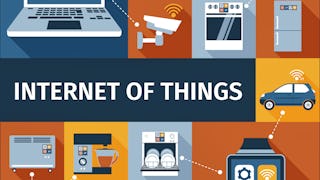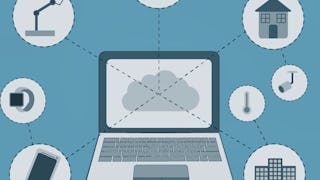Enroll in "Introduction to Internet of Things," a meticulously curated course by the eminent faculty of IIT Bombay in conjunction with TIH Foundation for IoT & IoE. This comprehensive course, spanning four modules, equips learners with foundational knowledge and skills essential to navigate the dynamic landscape of IoT.

Profitez d'une croissance illimitée avec un an de Coursera Plus pour 199 $ (régulièrement 399 $). Économisez maintenant.

Introduction to Internet of Things



Instructeurs : Prof. Rajbabu Velmurugan
8 628 déjà inscrits
Inclus avec
(75 avis)
Expérience recommandée
Ce que vous apprendrez
Recall the core principles and characteristics of the Internet of Things (IoT) discussed in the course lectures and materials.
Explain the various applications and domain areas of IoT, including home automation, by synthesizing information from the course modules.
Implement knowledge of IoT components, networking protocols, and data analysis methodologies to solve IoT-related problems.
Evaluate the challenges and design goals associated with IoT architecture and implementation, and propose strategies to address them effectively.
Compétences que vous acquerrez
- Catégorie : Unsupervised Learning
- Catégorie : Pandas (Python Package)
- Catégorie : Regression Analysis
- Catégorie : Internet Of Things
- Catégorie : Digital Signal Processing
- Catégorie : Communication Systems
- Catégorie : Network Protocols
- Catégorie : Emerging Technologies
- Catégorie : Wireless Networks
- Catégorie : Data Analysis
- Catégorie : Scikit Learn (Machine Learning Library)
Détails à connaître

Ajouter à votre profil LinkedIn
17 devoirs
Découvrez comment les employés des entreprises prestigieuses maîtrisent des compétences recherchées

Il y a 4 modules dans ce cours
Led by Prof. Rajbabu Velmurugan, in the "Internet of Things (IoT): An Introduction" module, learners will embark on a comprehensive journey into the fundamentals of IoT. Lesson 1 delves into the very essence of IoT, exploring its applications and distinct characteristics. Progressing to Lesson 2, participants will uncover the diverse models and components of IoT, enriched with real-world examples like home automation. Concluding with Lesson 3, the module offers an in-depth analysis of IoT architecture and its design goals, ensuring a holistic understanding of the subject. With a well-curated blend of videos and insights, this module serves as an essential primer for anyone keen on grasping the basics of the IoT realm.
Inclus
14 vidéos4 lectures4 devoirs1 sujet de discussion
Led by Prof. Laxmeesha Somappa, the "Sensors & Interfaces" module offers a comprehensive exploration into the intricate world of sensors, their characteristics, and their interfacing techniques. Lesson 1 serves as a foundational introduction to the realm of sensors, delving into their classifications and providing in-depth case studies on select sensor types like accelerometers, displacement/proximity sensors, and temperature sensors. Building on this foundation, Lesson 2 dives into the vital characteristics that define and differentiate sensors, covering aspects such as sensitivity, accuracy, and response time. The subsequent lessons shift focus to the crucial process of sensor readout, with Lesson 3 elucidating the concepts and design choices surrounding Analog to Digital Conversion (ADC) and quantization, and Lesson 4 highlighting the non-idealities one might encounter, including opamp specific issues.
Inclus
17 vidéos4 lectures5 devoirs
Led by Prof. Gaurav S. Kasbekar, the "Networking of IoT Nodes" module delves deep into the mechanisms and challenges of connecting diverse IoT nodes, ensuring seamless communication and data exchange. Lesson 1 lays the foundation by introducing the concept of IoT nodes, their diverse applications in sectors like agriculture, healthcare, smart homes, and infrastructure, and outlines the challenges in their networking. Lesson 2 ventures into low power, low data rate networks, illuminating participants on the IEEE 802.15.4 standard, as well as cutting-edge technologies like LoRa and SigFox. In Lesson 3, the spotlight is on the integration of constrained devices, offering insights into 6LoWPAN, header compression, fragmentation, and routing protocols. Rounding off the module, Lesson 4 dives into messaging protocols essential for IoT, with a comprehensive overview of CoAP and MQTT, their formats, and communication intricacies.
Inclus
22 vidéos4 lectures5 devoirs
Led by Prof. Rajbabu Velmurugan, in the "Data Analysis for IoT" module, learners delve into the critical aspects of analyzing vast amounts of data generated by IoT devices. Beginning with an exploration of the significance of data analysis specifically for IoT in Lesson 1, participants will be introduced to the components, feasibility, and various types of learning methods tailored for IoT datasets, with hands-on Python-based implementations. Lesson 2 offers a deeper dive into specific data analysis techniques, encompassing linear regression, time-series models, and clustering methodologies. With a blend of theoretical insights and practical demonstrations, this module ensures that learners are well-equipped to harness the power of data in the IoT domain. Concluding with a special message from the CEO of TIH-IoT. This module is a blend of theoretical knowledge, practical insights, and real-world applications, ensuring learners are well-equipped to navigate the networking landscape of IoT.
Inclus
13 vidéos4 lectures3 devoirs
Instructeurs

Offert par
En savoir plus sur Electrical Engineering
 Statut : Essai gratuit
Statut : Essai gratuitUniversity of California, Irvine
 Statut : Prévisualisation
Statut : PrévisualisationPohang University of Science and Technology(POSTECH)
 Statut : Essai gratuit
Statut : Essai gratuitUniversity of California, Irvine
 Statut : Essai gratuit
Statut : Essai gratuitUniversity of Illinois Urbana-Champaign
Pour quelles raisons les étudiants sur Coursera nous choisissent-ils pour leur carrière ?




Avis des étudiants
75 avis
- 5 stars
76 %
- 4 stars
16 %
- 3 stars
5,33 %
- 2 stars
0 %
- 1 star
2,66 %
Affichage de 3 sur 75
Révisé le 13 août 2024
amazing and very useful course in growing one's career graph professionally
Révisé le 6 sept. 2024
the learning of IOT is very fixable and I have educated in IOT now thanking you
Révisé le 9 août 2024
Really good course to upgrade ur skills , i already knew abt whatever came in this course😃
Foire Aux Questions
To access the course materials, assignments and to earn a Certificate, you will need to purchase the Certificate experience when you enroll in a course. You can try a Free Trial instead, or apply for Financial Aid. The course may offer 'Full Course, No Certificate' instead. This option lets you see all course materials, submit required assessments, and get a final grade. This also means that you will not be able to purchase a Certificate experience.
When you purchase a Certificate you get access to all course materials, including graded assignments. Upon completing the course, your electronic Certificate will be added to your Accomplishments page - from there, you can print your Certificate or add it to your LinkedIn profile.
Yes. In select learning programs, you can apply for financial aid or a scholarship if you can’t afford the enrollment fee. If fin aid or scholarship is available for your learning program selection, you’ll find a link to apply on the description page.
Plus de questions
Aide financière disponible,





